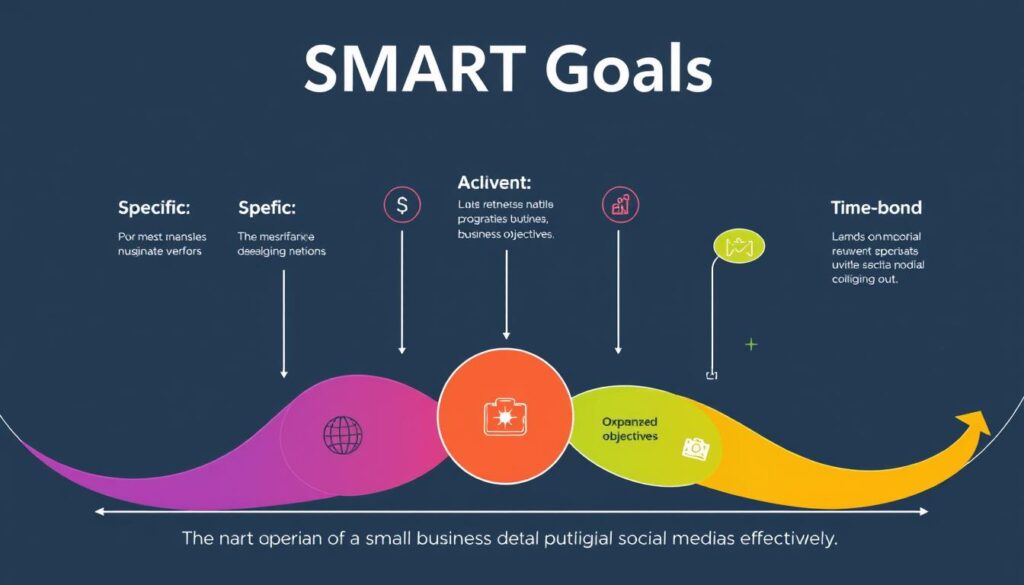Small businesses face a big challenge in today’s fast-changing digital world. Social media marketing has become a key tool for growth. But, how can you use it to boost your business in 2025?
The answer is to create a solid social media plan that fits your business goals. By using platforms like social media, you can reach more people, build your brand, and sell more. Social media marketing is great for growing your brand, engaging customers, and reaching a global audience.
Table of Contents
Understanding the Fundamentals of Social Media Marketing
Social media is now a key part of our digital world. It lets businesses talk directly to their audience. For small business owners, knowing how to use social media is key to growing and succeeding.
What Makes Social Media Essential for Business Growth
Social media marketing helps brands talk to users and build trust. It’s a great way for small businesses to connect with customers, show off their products, and stay in the minds of their audience.
Key Benefits of Social Media Marketing
- Cost-effective marketing: Social media is a cheap way for small businesses to reach more people and share their marketing benefits.
- Improved customer engagement: It lets businesses talk to customers, get feedback, and build stronger bonds.
- Targeted advertising: Social media has advanced tools for finding the right customers, helping businesses reach their perfect audience.
Current Social Media Landscape
The world of social media is always changing, with new sites and features popping up all the time. Small businesses need to keep up with these changes to stay connected with their audience in the fast-paced digital landscape.

Setting Clear Social Media Goals and Objectives
Creating clear, SMART (Specific, Measurable, Attainable, Relevant, Time-bound) goals is key for your small business’s social media success. These social media objectives should match your overall marketing strategy. They should also fit each platform’s strengths and audience.
First, figure out what’s most important for your business, like growing your brand or getting more leads. Next, make these goals specific and measurable using the SMART framework. For example, aim to grow your LinkedIn followers by 20% in six months or cut down Facebook Messenger wait times by 30% in three months.
- Common social media goals include generating leads, driving website traffic, and building brand awareness.
- SMART goals should be Specific, Measurable, Achievable, Relevant, and Time-bound.
- Examples of SMART goals: Increasing audience shares on LinkedIn by 20% in 6 months, reducing customer wait time on Facebook Messenger by 30% in 3 months.
To see how you’re doing, look at real metrics like engagement, clicks, and sales. Use social media analytics tools to check your return on investment (ROI). This way, you can keep improving your social media strategy.

By setting clear, data-driven SMART goals and linking them to your business goals, your social media efforts will help your business grow. This ensures your social media work leads to real success for your small business.
Identifying and Understanding Your Target Audience
Creating a good social media plan starts with knowing your audience. By making detailed audience personas and looking at demographic and behavioral insights, you can make your content and messages hit the mark. This way, you can connect better with your customers.
Creating Detailed Audience Personas
Make detailed audience personas based on things like age, where they live, how much they make, and what they like. These personas show who your typical customers are. They help you make social media content that’s more personal and targeted.
- Include demographic data like age, gender, income, and education level.
- Look at psychographic factors, like lifestyle, values, and what drives their buying decisions.
- Know what problems your audience faces, what they want to achieve, and how they like to interact on social media.
Analyzing Audience Demographics and Behavior
Use social media analytics tools to learn about your audience’s demographics and behavior. This info can guide your content strategies and help you get better on different platforms.
- Look at your followers’ age, gender, location, and other key demographics.
- Check how your audience interacts with your content, like likes, shares, and comments.
- Find out the best times and days to post to get more views and interactions.
Understanding Platform-Specific User Preferences
Each social media site has its own way of doing things. Make your content and how you engage with your audience fit the unique vibe of each platform.
By really getting to know your target audience, you can make social media campaigns that are more personal and effective. This can lead to more engagement, loyalty, and growth for your small business.
Choosing the Right Social Media Platforms for Your Business
Choosing the right social media channels for your small business is key. You need to pick platforms that match your target audience and marketing goals. Look at each platform’s unique features and who uses them to find the best fit for your brand.
Instagram and Pinterest are great for businesses with beautiful products. They focus on photos and short videos. LinkedIn is best for professional services and B2B companies. It’s a place to show off your expertise and lead in your field.
Facebook and X (formerly Twitter) are good for a wide range of content. They let you share text, photos, and videos. Think about how each platform likes to communicate to make your content fit right in.
Choosing the right platforms is all about knowing your target audience and their social media habits. Use research, look at your competitors, and listen to your customers. This will help you pick the social media channels that best reach your ideal customers.
- Analyze platform-specific demographics and user behaviors to make informed decisions.
- Select platforms that align with your business goals and target audience’s preferences.
- Tailor content and engagement strategies to each platform’s unique communication style.
The social media world is always changing. So, be ready to adjust your platform selection as your business and target audience evolve.
How to Use Social Media for Small Business Growth
As a small business owner, using social media can change your game. It helps you connect with your audience, build strong relationships, and grow your business. By using these platforms wisely, you can achieve great results.
Building a Strong Online Presence
Create engaging social media profiles that show off your brand. Make sure your profiles look the same everywhere, so people can easily recognize your business. Spend time on your bio, images, and content to attract your target audience.
Engaging with Your Community
Social media is about community engagement. Talk to your followers by answering comments and sharing their content. Create fun stuff like polls and Q&As to keep things interesting. This builds trust and makes your brand seem friendly and focused on customers.
Measuring and Adjusting Strategies
Use social media analytics to measure your content’s success. Look at how many people see your posts, how they interact, and if they buy from you. This info helps you understand what your audience likes. Use it to improve your social media strategy and make your business better.
Creating Compelling Content Strategies
Creating successful content strategies is key for small businesses on social media. Start by making sure your content fits your brand and what your audience likes. Mix up the types of content you share to keep things interesting and valuable.
Use different formats like images, videos, and articles to reach more people. Plan your content with a calendar that includes important dates and events. This way, you keep your content creation consistent and engaging.
- Analyze audience preferences using tools like Sprout Social’s engagement tactics and AI-powered insights
- Conduct competitive content analysis to benchmark your strategies
- Leverage quantitative data to optimize post performance and content mix
- Incorporate diverse content types like short-form videos, user-generated content, and live streams
- Utilize scheduling and publishing tools to streamline your content creation workflow
The secret to success is giving value to your audience. Create content that teaches, entertains, and inspires. This approach will help you use social media content to engage your audience and grow your business.
Developing a Content Calendar and Posting Schedule
Creating a strong social media plan means planning your content well. This includes picking themes, topics, and when to post. A good social media calendar saves time, makes your content better, and keeps your brand online presence steady.
Planning Content Themes
First, decide on content themes that match your business goals and what your audience likes. Mix up promotional, educational, and fun content. Think of topics that are valuable, engaging, and show off your brand’s skills.
Optimal Posting Times
Find out the best times to post on each social media site to get more views and interactions. Consider your audience’s time zones and the site’s algorithms. Use tools to plan your posts ahead and keep your schedule consistent.
Content Mix Recommendations
- Try to mix up your content types, like text, images, videos, and interactive stuff.
- Include both your own content and stuff from others in your field.
- Check your performance often to see what works and what doesn’t. This helps you improve your content planning and posting schedule.
With a detailed content calendar and posting schedule, you can make your social media work better. You’ll connect more with your audience and help your business grow.
Leveraging Visual Content and Storytelling
In today’s fast-changing social media world, visual content and storytelling are key for small businesses to grow. By using visuals and telling engaging stories, you can grab your audience’s attention. This helps your brand stick in their minds and boosts interaction with your customers.
Visual marketing is a must. Instagram is top for both paid and free post interactions, says Emplifi’s 2024 report. User-generated content can boost reach and engagement by a lot, Emplifi finds. So, using Instagram Reels or TikTok videos is smart for quick engagement.
Brand storytelling is also crucial. 54% of shoppers check online pictures or videos before buying, Emplifi’s data shows. By sharing your story, customer tales, and behind-the-scenes, you make your brand relatable. Live videos on Facebook are great for real-time chats with customers.
To boost your social media, add interactive visuals like AR filters, carousel posts, and GIFs. These formats grab attention and get people involved, leading to more engagement.
For small businesses, mixing visual marketing and content creation is key. By using visuals and stories, you can lift your brand, build loyalty, and make the most of social media.
Implementing Effective Social Media Advertising
Social media advertising is a key tool for small businesses looking to grow. With over 5.17 billion users worldwide, it’s a great way to reach people. This makes it easier than ever to find your audience.
Ad Campaign Setup and Management
You can use special tools to make ads for social media. These ads can help you get more website visitors, leads, or sales. It’s important to make ads that speak to your audience.
Budget Allocation Strategies
Managing your ad budget is crucial. Look at how your ads are doing and change your spending as needed. Facebook and Instagram let you set daily budgets from $1 to $50. This helps you find what works best for your business.
Performance Tracking Methods
Use tracking pixels and analytics to see how well your ads are doing. Watch things like click-through rates and ROI. This helps you improve your social media ads, campaign management, and ad performance.
Social media ads can really help your small business grow. By using the right platforms and making great ads, you can reach more people. This way, you can grow your business in a targeted and effective way.
Building and Engaging Your Social Media Community
In the world of small business growth, having a strong social media community is key. By talking to your audience, you create a sense of belonging. This helps your brand grow and succeed. Here’s how to grow and care for your social media community:
To begin, answer comments and messages quickly. This shows you care and builds trust. Also, host Q&A sessions, polls, and live streams to get your audience involved. These activities increase engagement and give you insights into what your audience likes.
- Share user-generated content to strengthen your community and keep followers loyal.
- Use a consistent brand voice on all social media to keep your brand’s identity strong.
Building a strong social media community takes time and effort. Focus on community management, audience engagement, and social interaction. This way, you can make your brand more visible, connect deeper with people, and help your small business grow over time.
Utilizing Social Media Analytics and Metrics
As a small business owner, using social media analytics is key for growth. It helps you make smart choices. You can learn a lot about your audience and content.
Begin by using tools from Facebook, Twitter, Instagram, and LinkedIn. These tools give you lots of data. You can see how people engage with your content and more.
Also, use third-party tools like Sprout Social or Google Analytics. They give you a bigger picture. You can see how different channels work together and make better reports.
Set SMART goals for your social media. Check your analytics often to see how you’re doing. This way, you can make your content better and grow your business.
Use analytics to see what content works best. Find out when people are online and how your efforts help your business. With data, you can make better choices and grow your business.
Integrating Social Media with Overall Marketing Strategy
To grow your small business, it’s key to link your social media with your marketing strategy. By matching your social media plans with your business goals, you make a strong brand. This helps your marketing work better together.
Cross-Platform Integration
Use cross-platform integration to reach more people and get more engagement. Run campaigns that work well on different social media, your website, and emails. This integrated marketing keeps your brand message clear and improves customer experience.
Aligning with Business Goals
Make sure your social media goals match your business goals. Whether it’s getting more people to know your brand, visiting your website, or buying more, social media should help. By linking your cross-channel strategy, you show how social media helps your business grow and get more money for it.
Marketing Channel Synergy
Connect your social media marketing with other digital marketing like content, email, and SEO. Use each platform’s strengths to make your brand stronger. A smooth, multi-channel plan boosts your marketing’s effect.
The secret to social media’s power for small businesses is integrating it with your marketing. By aligning your social media with your business goals and using a unified strategy, you build a strong brand. This leads to lasting growth.
Addressing Common Social Media Challenges
As a small business owner, dealing with social media can be tough. Changes in algorithms and too much content are just a few hurdles. But, by getting ready for these issues, you can find ways to beat them and reach your goals.
One big social media obstacle is algorithm changes. These changes affect what your audience sees. It’s key to troubleshoot your strategy often and adjust your posts and schedule.
Dealing with negative feedback or PR issues is another challenge. Having a plan for crises can help you handle them well. By being proactive with marketing solutions, you can turn bad situations into chances to show your brand’s dedication to customers.
- Stay informed about platform policy changes and adjust your strategies to comply with new requirements.
- Diversify your content types and sources to avoid content burnout and maintain audience engagement.
- Utilize scheduling tools and prioritize your tasks to manage your time effectively, ensuring a consistent social media presence.
Remember, beating social media challenges is a continuous effort. Stay flexible, use data, and keep your audience in mind. This way, you can overcome obstacles and help your small business grow.
Conclusion
Leveraging social media can be a game-changer for small businesses in 2025 and beyond. By understanding social media marketing basics, setting goals, and knowing your audience, you can craft a solid social media strategy. This strategy should match your business goals.
Choosing the right platforms, creating engaging content, and interacting with your audience are key. Also, keep an eye on how well your efforts are doing. This way, you can tweak your approach as needed to stay on top in the fast-changing social media world.
Social media is a huge chance for small businesses to shine in digital marketing. It’s a vital part of your marketing plan. By keeping your strategy fresh and adapting to new trends, you can grow your business and outdo competitors in 2025 and later.


